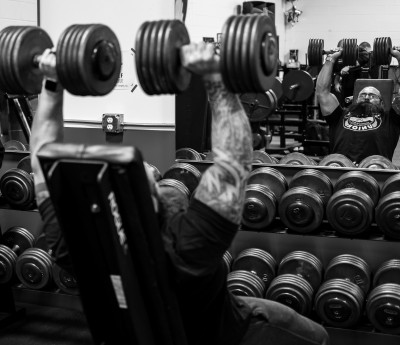
The human baseline hypothesis states that the strength a person possesses before they start the actual process of weight training is more indicative of long-term health benefits than weight training in and of itself. Even if a person increases their strength beyond that baseline it has no real positive effect on their long-term health.
In a meta-analysis by Cornelissen et al 2011 on the impact of resistance training on blood pressure and other cardiovascular risk factors they found that there was a positive effect on blood pressure with normotensive or prehypertensive study groups, they found no significant effect at all with groups that were hypertensive to begin with. In a more recent study by Nascimento et al 2018 they took 27 untrained hypertensive and 12 normotensive elderly women and put them on a whole-body RT program and both groups had significant improvements in the systolic blood pressure. They did see a different in responders and non-responders to the amount of improvement and suggested they seek additional training modalities to find what works best. I think long-term resistance training can have a positive effect on blood pressure by controlling people’s insulin which we know insulin resistance can have a negative effect on the heart and blood pressure so it may not have a direct impact although some research tends to think it does I think the indirect benefits can shed some better light on how resistance training can improve it.
If I was training for overall health I would use a wide variety of modalities to improve my markers such as HDL, LDL, BG, HA1C, Insulin, Thyroid, Hormones, and BP. In a meta-analysis by Owen et al 2010 they showed the best improvements for blood pressure where related to isometric handgrip exercises. In another study by Duncan et al 2003 they took 18 sedentary people and just had them walk for 6 months at 45-55 or 65-75% HRR for 3-4 or 5-7 days a week and fund that both groups improved insulin sensitivity without losing weight. In another study by Poehlman et al 2000 they took 41 young nonobese women and put 14 in an endurance group, 17 in a resistance training group, and 20 in a control group. They found that both exercise groups improved insulin sensitivity but they concluded that it was from different mechanisms. An increase in the amount of free fat mass from resistance training contributes to an increase glucose disposal probably from a mass effect, without altering the intrinsic capacity of the muscle to respond to insulin. Based off of the information presented I would form a resistance program that incorporated some isometric grip holds along with some dynamic resistance training to take a more holistic approach of improving insulin and blood pressure. Couple that with some form of cardiovascular type training whether it be walking for beginners or some type of formal aerobic style training.
One of the best predictors of cause-specific mortality is grip strength (Sasaki et al 2006) and we understand that anthropometrics is a huge determinate of hand grip strength. The bigger the hand the better the grip (Fallahi and Jadidian 2011) but there has been some recent research that shows you can make improvements in hand grip strength. A study by Kim and Yim 2017 took 29 patients with cognitive function disorder and put 14 in an exercise group and 15 in a control group. They found a significant improvement in the affected side and no difference in the unaffected side which falls in line with the idea that hand grip strength is something you either have or don’t but if you have some type of disorder it could be improved. By improving the grip strength, they saw an improvement in cognitive function but they also improved walking ability so it is hard to say which one had the greatest impact. Based on this finding and other research I’d say it is better to be born strong than to build strength when it comes to mortality but I think if you are not strong that becoming stronger will help improve mortality just not as good as those who were already born strong. If health is your goal which at some point it will need to shift that way, you now have some information on what to improve and how to improve. Biggest takeaway don’t have a wet noodle for a handshake it’s bad for your health.
Sasaki, H., Kasagi, F., Yamada, M., & Fujita, S. (2007). Grip strength predicts cause-specific mortality in middle-aged and elderly persons. The American Journal of Medicine, 120(4), 337-342. https://doi.org/10.1016/j.amjmed.2006.04.018
Fallahi, A., & Jadidian, A. (2011). The effect of hand dimensions, hand shape and some anthropometric characteristics on handgrip strength in male grip athletes and non-athletes. Journal of Human Kinetics, 29(1), 151-159. https://doi.org/10.2478/v10078-011-0049-2
Kim, J., & Yim, J. (2017). Effects of an exercise protocol for improving handgrip strength and walking speed on cognitive function in patients with chronic stroke. Medical Science Monitor, 23, 5402-5409. https://doi.org/10.12659/msm.904723
Duncan, G. E., Perri, M. G., Theriaque, D. W., Hutson, A. D., Eckel, R. H., & Stacpoole, P. W. (2003). Exercise training, without weight loss, increases insulin sensitivity and Postheparin plasma lipase activity in previously sedentary adults. Diabetes Care, 26(3), 557-562. https://doi.org/10.2337/diacare.26.3.557
Owen, A., Wiles, J., & Swaine, I. (2010). Effect of isometric exercise on resting blood pressure: A meta analysis. Journal of Human Hypertension, 24(12), 796-800. https://doi.org/10.1038/jhh.2010.13
Poehlman, E. T. (2000). Effects of resistance training and endurance training on insulin sensitivity in Nonobese, young women: A controlled randomized trial. Journal of Clinical Endocrinology & Metabolism, 85(7), 2463-2468. https://doi.org/10.1210/jc.85.7.2463
Cornelissen, V., Fagard, R., & Vanhees, L. (2010). The impact of dynamic resistance training on blood pressure and other cardiovascular risk factors: A meta-analysis of randomized controlled trials: 5d.03. Journal of Hypertension, 28, e229-e230. https://doi.org/10.1097/01.hjh.0000378890.52094.5c
Nascimento, D. D., Da Silva, C. R., Valduga, R., Saraiva, B., De Sousa Neto, I. V., Vieira, A., Schwerz Funghetto, S., Silva, A. O., Da Cunha Oliveira, S., Borges Pereira, G., Willardson, J., & Prestes, J. (2018). Blood pressure response to resistance training in hypertensive and normotensive older women. Clinical Interventions in Aging, 13, 541-553. https://doi.org/10.2147/cia.s157479
Buckner, S. L., Dankel, S. J., Mouser, J. G., Mattocks, K. T., Jessee, M. B., & Loenneke, J. P. (2017). Chasing the top quartile of cross-sectional data: Is it possible with resistance training? Medical Hypotheses, 108, 63-68. https://doi.org/10.1016/j.mehy.2017.08.009









